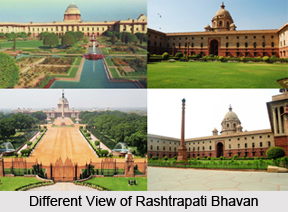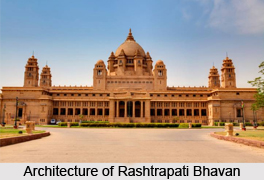 Rashtrapati Bhavan is the official residence of the Indian President. Presently, it is the largest residence of any Chief of the State in the world. The splendour of the Rashtrapati Bhavan is multi-dimensional. It is a vast mansion and its architecture is breathtaking. More than these, it has a sacred existence in the history of democracy for being the residence of the President of the largest democracy in the world. Few official residential premises of the Head of the State in the world will match the Rashtrapati Bhavan in terms of its size, vastness and its magnificence.
Rashtrapati Bhavan is the official residence of the Indian President. Presently, it is the largest residence of any Chief of the State in the world. The splendour of the Rashtrapati Bhavan is multi-dimensional. It is a vast mansion and its architecture is breathtaking. More than these, it has a sacred existence in the history of democracy for being the residence of the President of the largest democracy in the world. Few official residential premises of the Head of the State in the world will match the Rashtrapati Bhavan in terms of its size, vastness and its magnificence.
History of Rashtrapati Bhavan
The present day Rashtrapati Bhavan was the previous residence of the British Viceroy. Its architect was Edwin Landseer Lutyens. The decision to build a residence in New Delhi for the British Viceroy was taken after it was decided in the Delhi Durbar of December 1911 that the capital of India would be shifted from Calcutta (now Kolkata) to Delhi in the same year. Rashtrapati Bhavan was constructed to affirm the permanence of British rule in India. This building gave the impression, in the words of a critique, the setting of a perpetual Durbar. The building and its surroundings were supposed to be `an empire in stone`, `exercising imperial influence.` This building transformed to be the permanent institution of democracy on 26th January 1950 when Dr. Rajendra Prasad became the first President of India and occupied this building to preserve, protect and defend the Constitution of India. It was from that day that this building was renamed as Rashtrapati Bhavan the President`s House. Apart from Edwin Lutyens, the Chief architect and Chief Engineer Hugh Keeling there were many Indian contractors who were involved in the construction of this building.
Site and Architecture of Rashtrapati Bhavan
The Rashtrapati Bhavan is vast mansion with four floors and 340 rooms. With a floor area of 200, 000 square feet it is built by using 700 million bricks and three million cubic feet of stone. Hardly any steel has gone into the construction of the building. The most prominent and distinguishing aspect of Rashtrapati Bhavan is its dome, which is placed over its structure. It is visible from a distance and the most eye-catching round roof with a circular base in the heart of Delhi. It is very strongly believed by informed analysts that the dome was structured in the pattern of the great Sanchi Stupa. In fact the whole of Rashtrapati Bhavan embodies in it Indian architectural patterns such as Buddhist railings, chhajjas, chhatris and jaalis.
 Chhajjas are stone slabs which are fixed below the roof of a building and are designed for the purposes of preventing the sunrays from falling on the windows and protecting the walls from the rains in the monsoon. Jaalis, like chhajjas and chhatris, are also of typical Indian designs, which add beauty to the architecture of the Rashtrapati Bhavan. Jaalis are the stone pieces containing lots of scratch, which are designed with delicate floral and geometric patterns.
Chhajjas are stone slabs which are fixed below the roof of a building and are designed for the purposes of preventing the sunrays from falling on the windows and protecting the walls from the rains in the monsoon. Jaalis, like chhajjas and chhatris, are also of typical Indian designs, which add beauty to the architecture of the Rashtrapati Bhavan. Jaalis are the stone pieces containing lots of scratch, which are designed with delicate floral and geometric patterns.
Another enduring feature of the architecture of the Rashtrapati Bhavan is the use of Indian temple bells in its pillars. It is well known that the temple bells constitute part and parcel of our combined culture, particularly that of Hindu, Buddhist and Jain traditions. Blending these bells with the Hellenic style architecture is a fine example of the fusion of Indian and European designs.
The President of India does not occupy the suites now called Ashoka room, occupied by the Viceroys. Instead he occupies one of the guest bedrooms. The First Indian Governor General, Chakravarti Rajagopalachari, considered the master bedroom too glittery for his humble tastes. All Presidents thereafter have followed the tradition. The Rashtrapati Bhavan is the biggest resident of any President in the world. The Rose Garden in Rashtrapati Bhavan displays numerous types of roses and is open to public in February every year. No steel was used to construct the Rashtrapati Bhavan.
Rashtrapati Bhavan today is known as India`s best monument after the Taj Mahal and the Qutub Minar. It is unquestionably a masterpiece of symmetry, discipline, silhouette, colour and harmony. Though, Rashtrapati Bhawan has been criticized too much, but that has mostly been limited to the imperial intent behind it rather than its architecture.



















